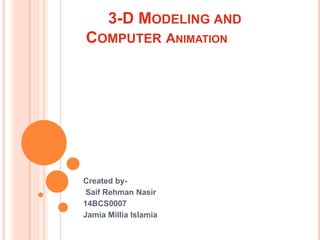
3D Modelling and Animation
- 1. 3-D MODELING AND COMPUTER ANIMATION Created by- Saif Rehman Nasir 14BCS0007 Jamia Millia Islamia
- 2. COURSE CONTENTS 3-D Modeling • Introduction • Methods of 3-D Modeling • Some applications in real world scenario Computer Animation • Introduction • Types of Computer Animation • Methods of animation used earlier • Methods of animation using computers/CGI • Applications in real life
- 3. 3-D MODELING In the world of computer design, 3D modeling is the process of developing graphics and images that appear to have three dimensions. Designers use various three dimensional modeling methods to create realistic character models. These models are typically characterized by their life-like look and apparent depth .
- 4. TYPES OF MODELING Primitive Modeling • The simplest way of modeling 3D objects • Involves the use of geometric basics such as cylinders, cones, cubes and spheres • Mathematically defined and precise forms • Easy for relative beginners
- 5. Polygonal Modeling • A slightly more advanced approach • Involves connecting line segments through points ,known as vertices, in a 3D space • One cannot, however, create an exact curved surface using polygonal 3D modeling technique • Most effective and precise technique • Used in creation of either organic(irregular surface) or hard objects
- 6. NURBS Modeling • Non-uniform rational B-spline modeling(NURBS) • One of the best ways to create truly curved smooth surfaces. • NURBS modeling actually does “bend” the space. • Commonly used in computer-aided design (CAD), manufacturing (CAM), and engineering (CAE) • The control points determine the shape of the curve.[6] Typically, each point of the curve is computed by taking a weighted sum of a number of control points.
- 7. Digital Sculpting/Sculpt Modeling • Manipulating a digital object to push, pull, smooth, grab, pinch or otherwise • Uses mesh based geometry • An object is represented by an interconnected surface mesh of polygons that can be manipulated • Supports sculpting at multiple resolutions on a single model
- 8. APPLICATIONS
- 9. Entertainment Applications Video gaming industry is one of the most commonly recognized application A number of motion pictures and movies make use of 3D imaging and viewing
- 10. Industry In medical field,to create detailed models of human body organs. 3D computer aided design (CAD) programs to create three dimensional models Architectural design and urban pipeline dynamics Reconstructing faces of an ancient species or civilizations
- 11. COMPUTER ANIMATION ‘To animate’ is to create movement Animation adds to graphics the dimensions of time, which tremendously increase the potential of transmitting the desired information In otherwords, It is a kind of visual digital display technology that simulates moving objects on-screen
- 12. TYPES OF ANIMATION Computer-assisted animation Also known as two-dimensional (2D) animation Creators drawings either hand drawn or drawn with the help of a computer using different assisting appliances Drawings are placed into different key frames which outline the most important movements Computer will then fill in all the " in-between frames", commonly known as Tweening. An example is GIF format used throughout this presentation
- 13. Computer Generated animation Also known as 3-dimensional (3D) animation Designs an object or character with an X,Y and Z axis Computer generated imagery(CGI) used Animators can break physical laws by using mathematical algorithms to cheat, mass, force and gravity rulings.
- 14. HOW ANIMATIONS WERE DONE BEFORE CGI
- 15. 1.KEYFRAMEANIMATION In this technique a storyboard is laid out and then the artists draw the major frames of the animation. Then they draw in the frames in between.
- 16. CELANIMATION In this technique each character is drawn on a separate piece of opaque paper. at the animation level the characters are overlaid on top of the background in each frame.
- 17. ROTASCOPING Rotascoping is a technique where images are copied from a moving video into an animation. The animator draws the motion and shape of the object by referring to the video .
- 18. METHODS OF ANIMATION USING CGI
- 19. KEYFRAMING "Keyframing" can be traced back to traditional hand animation technique. The computer then automatically fills in the missing frames by smoothly interpolating between those positions.
- 20. MOTIONCAPTURE Magnetic or vision- based sensors record the actions of a human or animal object in three dimension s. A computer then uses these data to animate the object.
- 21. SIMULATION It uses the laws of physics to generate motion of figures and other objects. Virtual humans are usually represente d as a collection of rigid body parts
- 23. MEDICALANIMATION A short educational film, usually based around a physiological or surgical topic, rendered using CGI. Medical animation is most commonly utilized as an instructional tool for medical professionals or their patients.
- 24. ARCHITECTUREVISUALIZATION A computer- generated building is created along with landscaping and sometimes moving people & vehicles. Used in protraying a township.
- 25. MECHANICALANIMATION Creation virtual models of products and mechanical designs can save companies thousands to millions of dollars, by cutting down on development costs. Animation can let developers eliminate a lot of problems that would normally require extensive physical test models & experimentation.
- 26. FORENSICANIMATION It is a branch of forensics in which animated recreation of incidents are created to aid investigators & help solve cases. Examples include the use of computer animation, stills, and other audio visual aids.
- 27. GAMINGAPPLICATIONS CGI is widely used for gaming applications . Every instance, more and more sophisticate d games are being released thanks to CGI.
- 28. THANK YOU FOR YOUR PATIENCE AND TIME!!